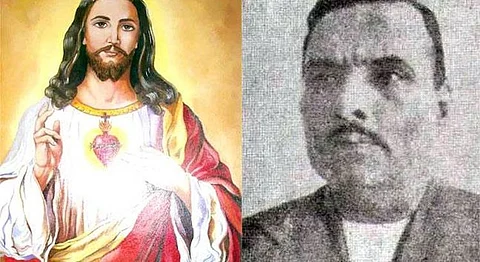
- HOMEGROWN WORLD
- #HGCREATORS
- #HGEXPLORE
- #HGVOICES
- #HGSHOP
- CAREERS
- ABOUT US
- CONTACT US

In Christian theology Jesus Christ was born in Bethlehem, followed to preach in Jerusalem, and spent his life in what is now modern-day Israel. That's the story we've all grown to know and accept via either jesuit schooling or common cultural knowledge. Ganesh Damodar Savarkar in his book Christ Parichay, however, tells quite a different tale. One of the founders of the Rashtriya Swayamsevak Sangh (RSS), Savarkar’s book was originally published in Marathi back in 1946. Fast forward seventy years to the present and the book, which claims that Jesus was in fact a Vishwakarma Brahmin by birth and that Christianity is a cult of Hinduism, will be back in circulation on February 26, being republished by the Swatantryaveer Savarkar National Memorial in Mumbai.
Apart from Jesus being a Tamil Hindu by birth, the book makes several controversial claims; though numerous conspiracy theories exist regarding Christ, including his supposed links to India, people have found Christ Parichay’s statements quite absurd and far-fetched. In the book Savarkar writes that Jesus Christ had a dark complexion, his real name was Keshao Krishna and Tamil was his mother tongue. Following brahminical tradition, his sacred thread ceremony janeyu took place when he was 12 and he even wore the sacred thread. People of the Essenes cult, who were practitioners of yoga and spiritual sciences, saved Christ after his crucifixion, treating him with a number of medicinal herbs and plants, revived him from his deathbed and then took him to Kashmir.
The book adds that his last days were spent in the Himalayas praying to Lord Shiva, and it is here his burial tomb exists and is known by his name. Savarkar claims Arabic has many Sanskrit and Tamil words; he further notes that Palestine's Arabic Language was a version of the Tamil language, even adding that the name Joseph was derived from Sheshep, which is further derived from Sheshappa, a common Tamil name. Jesus’ family dressed in typical traditional Indian attire, he writes, and the family had Hindu signs on their bodies.
“There is no mala fide intention in reprinting this particular book after 70 years,” Ranjit Savarkar, executive president, Swatantryaveer Savarkar National Memorial, told Mid-day. “It is one of the books that my grandfather (Ganesh Savarkar) authored. His books are not available and hence, we have decided to publish them again for the benefit of readers. I know some people will raise questions. But then what Ganesh Savarkar has written in this book is not new. Many others have researched on the similar lines and drew their own conclusions. Ganesh Savarkar too did his research before writing the book.”
Such sensational statements could cause quite a stir among the Christian communities, hurting several sentiments, but Father Warner D’Souza, senior priest and director of the Bombay Archdiocesan Heritage Museum, states that such books won’t really affect Christians who are true to their beliefs, adding that concentrating on such hypothetical historical questions, such as Jesus’ possible burial in Kashmir, is a waste of time. “Ours is a country that is deeply and beautifully religious and we think God resides in our hearts,” he said. “A few people upset everybody else by these claims, but by and large, this is such a beautiful country of faith. And the gospels themselves and the New Testament were not written to give us historical facts. They are to give faith and experience to their disciplines. So, such a book will hardly disturb true Christians. More importantly, no Christian should be disturbed, and less importance such things are given, the better.”
While we may raise a questioning eyebrow at a book which declares that Christ was an incarnation of Lord Shiva or Lord Vishnu by the followers residing in Palestine and surrounding areas, Savarkar is adamant in his beliefs. “I have presented evidence, references, names of books and portraits, to prove that Christ was a Hindu. He returned to India to study the Vedas, and became an expert in Yoga and then returned to his country to preach the right path or religion. While preaching, he got involved in a political storm and was crucified, but miraculously escaped alive. Later, his stay in Palestine, openly or underground, became dangerous. Therefore, he came to India with a Yogi. He was a great personality, supposed to be an incarnation. After arriving in India he continued preaching till his death,” he writes in Christ Parichay. “This is in short the life history of Christ. To remind the Christian world that they have snatched away Christ's Hinduness and to repay the debt of Christ to us that he gave by hurling the flag of Hinduism beyond India, I have done this work and I am satisfied with it. Let this literary worship of Christ or Keshao the Krishna reach his divine feet.”
Feature image courtesy India Today
Written By Sara Hussain
